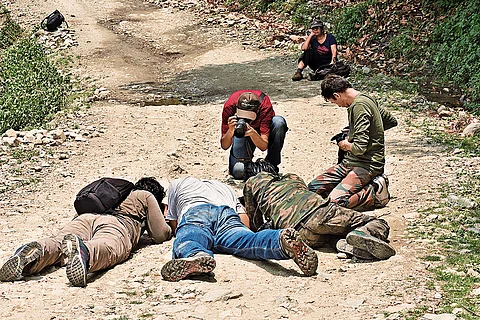
- Destinations
- Experiences
- Stay
- What's new
- Celebrating People
- Responsible Tourism
- CampaignsCampaigns
- Subscribe
- Buy Now

"What are all of you doing?” The voice startled me. I turned to see a 70-year-old man sitting on his haunches, walking stick in hand, watching us with curiosity. We were at Chiana Khud Titli Park in Devalsari, Tehri Garhwal, Uttarakhand. A group of 20 visitors from across the country had gathered by a small stream, cameras and binoculars in hand, for the 4th Devalsari Titli Utsav in May 2023. Some were sprawled on the ground photographing butterflies, others focused on damselflies, and a few admired and clicked pictures of wildflowers.
I explained to the old man that we were tourists who had come to observe and document Devalsari’s biodiversity as part of an annual community-led nature festival. His eyes widened. “What is so special that so many people have come to visit our village and its surroundings?” he asked. When I told him visitors were here to see birds, butterflies, moths, frogs, reptiles, and wildflowers, his expression shifted from curiosity to sheer disbelief.
The Devalsari Paryavaran Sanrakshan Awam Tekniki Vikas Samiti, a local youth group, organises the festival. To ensure a high-quality biodiversity experience, the number of visitors is capped. Activities include bird and butterfly watching, moth watching, night walks to observe nocturnal species like frogs, lizards, and insects, as well as heritage and village walks. Trained local guides lead these experiences with an emphasis on ethical nature watching—no call playback, no special viewing shelters, and no baiting. Experts deliver talks on biodiversity-related topics, adding depth to the festival’s programming.
Sustainability is at the heart of the event. Visitors must take back any non-biodegradable waste they bring, and bottled water is not allowed. Meals are prepared using organic ingredients sourced from nearby villages, and local cuisine takes centre stage. Even the festival’s inauguration follows strict environmental ethics—if local leaders or musicians participate, there are no microphones or loudspeakers to disturb the surrounding wildlife. Importantly, the festival is entirely self-funded, with visitor fees covering expenses. Now in its sixth year, the Devalsari Titli Utsav has built a strong reputation, drawing nature lovers from far and wide.
Devalsari is not an isolated example. Across the Himalayas, communities are independently promoting conservation and nature-based livelihoods without relying on government support. The Himal Kalasutra Festival at Sarmoli village has been organised for a decade by the local community with backing from NGOs such as Himal Prakriti, Maati, and Himalayan Ark.
In Pawalgarh, the NGO Pawalgarh Prakrati Prahari hosts annual nature meets. In Rathuadhab, the youth group Chakhuli launched the first Kalagarh Nature Festival in December 2024, while the Taknaur Hills Conservation Society, a youth collective from the Gangotri landscape, is planning the inaugural Gangotri Nature Festival in April 2025.
These initiatives extend beyond Uttarakhand. In the Northeast, young members of the Garo tribe in Meghalaya have been organising butterfly and moth meets in Karwani and Siju since 2015. In Gobuk village, Upper Siang district of Arunachal Pradesh, Epum Sirum and the Gobuk Welfare Society are preparing for their third biodiversity meet in May 2025. Meanwhile, the NGO Nguno Ziro has been running the Ziro Butterfly Meet for more than a decade at Ziro in the Lower Subansiri district. In the 2024 edition of the meet, more than 60 butterfly species, including the Bhutan glory and the brown gorgon, along with 52 bird species, were documented.
These initiatives are more than just celebrations of biodiversity—they are beacons of hope
These community-led festivals also contribute to biodiversity documentation. In Gobuk, the dark freak butterfly, endemic to Arunachal Pradesh and rare elsewhere, is a major attraction. At Devalsari, Arun Prasad, co-ordinator of Devalsari Environment Protection Committee, recorded swarms of Achelura bifasciata, a day-flying moth not documented in Garhwal for decades. In Kalagarh, the community showcases the silver-eared mesia, a bird commonly found in the Northeast but rarely seen in Uttarakhand. At the Ziro Butterfly Meet, the Bhutan glory and Kaiser-i-Hind, two of India’s most spectacular butterflies, are key highlights.
The common thread among these festivals is community leadership. These initiatives create livelihoods and empower local residents, fostering a deep sense of pride in conservation efforts. Each festival integrates nature awareness programmes for schools and the local community. NGOs such as Titli Trust and Green Hub play a crucial role in capacity-building and guiding organisers through the initial stages. Because these festivals are independent of government funding, they have continuity and stability.
Many of these pioneering efforts are inspiring other forest-dwelling communities to take ownership of conservation and nature-linked livelihoods. These initiatives are more than just celebrations of biodiversity—they are beacons of hope for sustainable conservation.
Get Your Copy Now!
Don't miss out on the latest issue of Outlook Traveller! Click here to grab your copy.
